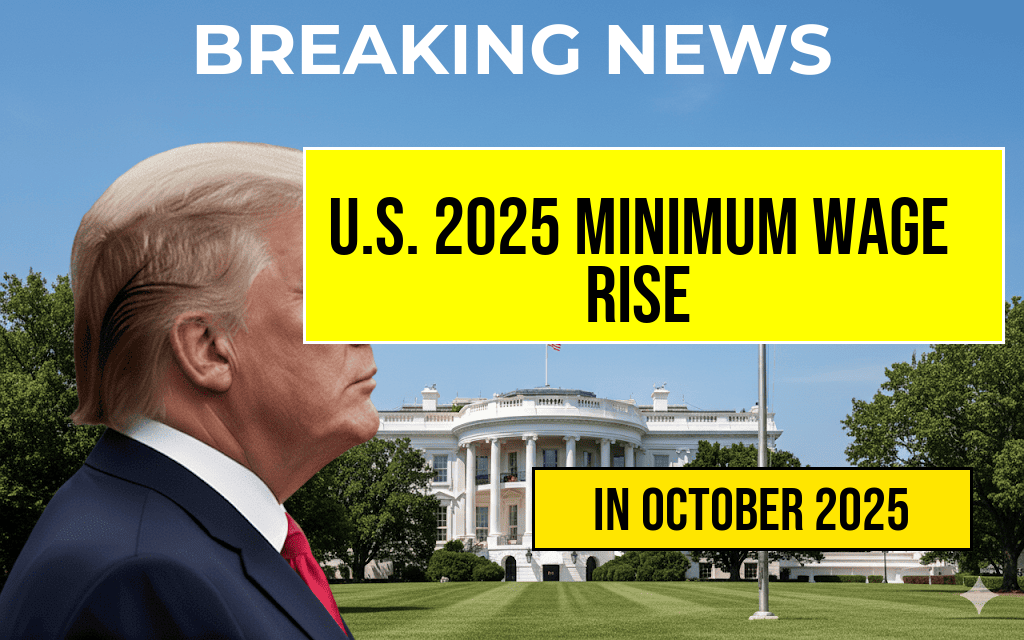Starting October 4, 2024, millions of workers across the United States will see an increase in their hourly wages as the federal minimum wage rises for 2025. The adjustment follows recent legislation enacted by Congress, which mandates a phased increase in the federal baseline pay rate to address inflation and improve living standards for low-wage earners. The new minimum wage will be $15.00 per hour, up from the current $14.50, marking a $0.50 increase that applies nationwide, with certain states and cities implementing their own higher rates. This update is expected to influence employment markets, consumer spending, and wage negotiations across various sectors. Employers are preparing for the change, with many adjusting payroll systems and revising staffing budgets. The increase also underscores ongoing debates over minimum wage policies, economic impacts, and regional disparities in pay standards.
Federal and State Minimum Wage Updates for 2025
Federal Minimum Wage Adjustment
The federal minimum wage, which has remained at $7.25 since 2009, was raised to $15.00 through the Fair Minimum Wage Act of 2021, which mandated a gradual increase over several years. The latest step in this phased approach, effective October 4, 2024, raises the federal rate by $0.50, reaching a new baseline of $15.00 per hour. This change impacts workers in businesses subject to federal labor laws, including those in hospitality, retail, and healthcare sectors. The Biden administration emphasizes that the increase aims to support economic recovery and reduce wage inequality.
State and Local Wage Variations
While the federal rate provides a minimum standard, many states and municipalities maintain higher minimum wages. For example, California’s minimum wage will increase to $16.00 per hour, while New York City continues to lead with a rate of $17.00. States such as Washington and Massachusetts also have set their minimum wages above the federal level, often adjusting annually based on inflation or legislative updates. Employers operating in multiple jurisdictions must navigate this patchwork of wage laws, ensuring compliance with the highest applicable rate in their region.
Impacts on Employers and Employees
Business owners are preparing for the wage hike by reviewing staffing budgets and adjusting pricing strategies. Some anticipate increased labor costs, which could influence hiring plans or lead to automation in certain sectors. Conversely, workers earning the new minimum wage are expected to see immediate financial benefits, particularly in industries with historically low pay scales. Analysts suggest that the wage increase could bolster consumer purchasing power, potentially stimulating economic activity in local communities.
Economic and Policy Implications
Wage Growth and Inflation
Proponents argue that raising the minimum wage helps combat inflationary pressures by increasing disposable income for lower-income households. The Congressional Budget Office (CBO) estimates that such increases could lift wages for millions but also cautions about possible employment effects, especially among entry-level workers. Critics, meanwhile, warn that higher wages may lead to increased costs for small businesses, potentially resulting in reduced hours or layoffs.
Regional Disparities and Future Outlook
Regional economic conditions heavily influence how wage increases impact local markets. Areas with a higher cost of living tend to adopt higher minimum wages, creating disparities across the country. As discussions about further wage hikes continue, policymakers remain divided over balancing fair pay with economic competitiveness. Some states have already announced plans to accelerate minimum wage increases beyond federal schedules, signaling a continued trend toward regional wage customization.
Summary of 2025 Minimum Wage Rates
| Region | Minimum Wage | Notes |
|---|---|---|
| Federal | $15.00 | Applicable nationwide for federal workers and contractors |
| California | $16.00 | Statewide minimum wage; localities may set higher rates |
| New York City | $17.00 | City minimum wage, higher than state minimum |
| Washington | $15.74 | Adjusted annually for inflation |
| Massachusetts | $15.00 | Statewide minimum wage |
As the October 4 implementation date approaches, both policymakers and industry leaders are closely monitoring the effects of the wage increase. The change signifies ongoing efforts to modernize wage policies amidst economic recovery efforts and inflation concerns. For more details on minimum wage laws and regional variations, resources such as Wikipedia’s minimum wage page and Forbes analysis provide comprehensive insights into the evolving landscape.
Frequently Asked Questions
What is the new minimum wage rate effective October 4, 2025?
The U.S. minimum wage has increased to an updated hourly rate effective October 4, 2025. The specific rate varies by state and locality, reflecting recent legislative adjustments.
Which states or cities have implemented the increased minimum wage?
Several states and cities across the U.S. have adopted the new minimum wage rates. To find the exact figures for your area, consult your local government or official state labor department resources.
How does this wage increase impact employers and employees?
The wage increase aims to improve living standards for workers while potentially affecting business costs for employers. Employers should update payroll systems accordingly to comply with the new rates.
Are there any exceptions or special rules for certain industries or worker categories?
Yes, some industries or worker classifications, such as tipped employees or youth workers, may have different minimum wage standards. Check specific regulations applicable to your sector for details.
When will the updated minimum wage rates be reflected in payroll and employee paychecks?
The updated wage rates will be effective starting October 4, 2025. Employers should ensure that all payroll systems are updated to reflect the new rates from this date forward to ensure compliance and proper employee compensation.







